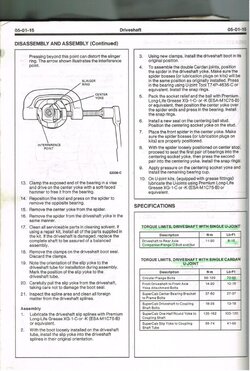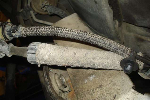AnthonyExplorer92
New Member
- Joined
- April 17, 2017
- Messages
- 5
- Reaction score
- 3
- City, State
- Bedford Hills, NY
- Year, Model & Trim Level
- 1992 Explorer XLT
Hello All
I see that rear driveshaft bolt torque settings have been discussed here and elsewhere before, and I've seen different answers, which seem to be the result of conflicting information between the 1992 Explorer Haynes manual and the Ford service manual (and possible inconsistencies within the service manual itself). So I just thought I'd double check to see if folks have resolved this definitively. (I just regreased the driveshaft slip joke for my 120,000 mile check on my manual tranny 1992 XLT 4x4, and I checked the U-joints, which are just fine. I got everything back in but want to be sure before I torque the bolts. I've done this in the past, but forgot what I did. I was confused then too!)
Here what I have for the rear shaft:
Rear shaft to transfer case connection:
The Haynes manual and service manual agree on 12 to 16 ft-lbs. But as others have said, that seems ridiculously low. Have folks used that and survived :O) ? I keep imagining the shaft falling out while I'm driving. In the past, I think I cranked them up higher, but I don't remember. (Many years ago I exceeded the recommendations for the front shaft bolts - which also seemed too low - and snapped off the head on one of them. So I'm reluctant to exceed what Ford says).
Rear shaft to rear differential:
This is where I get different numbers for what I think is a single cardan U-joint.
Haynes (see uploaded files "Haynes") says 8-15 ft-lbs (70-95 ft-lbs for the double cardan U-joint, which I don't have on the rear shaft).
The 1992 service manual seems to have two different numbers:
So....
Is the front okay at 12-16 ft-lbs without my wife and I prepaying for a funeral :O)?
Is the rear 8-15 ft-lbs or 70-to 95 ft-lbs (I'm thinking 70 to 95? and assuming the Haynes manual is wrong on the shaft-to-differential torque?
Thank you everyone for any help!
By the way, my 92 is still beautiful (I keep the bottom painted). The uploaded file Explorer92 shows it some years back, but it still looks just like this. I factory ordered it the way I wanted it: a rare cabernet (non-metallic) red, mocha interior, manual transmission, limited slip and the high-end sound system with subwoofer. And I actually can see out of the thing without needing radar, like many of today's vehicles, and the hatch window actually opens, so all my stuff doesn't fall out.
Happy motoring.
Anthony Giorgianni




I see that rear driveshaft bolt torque settings have been discussed here and elsewhere before, and I've seen different answers, which seem to be the result of conflicting information between the 1992 Explorer Haynes manual and the Ford service manual (and possible inconsistencies within the service manual itself). So I just thought I'd double check to see if folks have resolved this definitively. (I just regreased the driveshaft slip joke for my 120,000 mile check on my manual tranny 1992 XLT 4x4, and I checked the U-joints, which are just fine. I got everything back in but want to be sure before I torque the bolts. I've done this in the past, but forgot what I did. I was confused then too!)
Here what I have for the rear shaft:
Rear shaft to transfer case connection:
The Haynes manual and service manual agree on 12 to 16 ft-lbs. But as others have said, that seems ridiculously low. Have folks used that and survived :O) ? I keep imagining the shaft falling out while I'm driving. In the past, I think I cranked them up higher, but I don't remember. (Many years ago I exceeded the recommendations for the front shaft bolts - which also seemed too low - and snapped off the head on one of them. So I'm reluctant to exceed what Ford says).
Rear shaft to rear differential:
This is where I get different numbers for what I think is a single cardan U-joint.
Haynes (see uploaded files "Haynes") says 8-15 ft-lbs (70-95 ft-lbs for the double cardan U-joint, which I don't have on the rear shaft).
The 1992 service manual seems to have two different numbers:
On page 05-01-7 (see uploaded file ServiceManual1), it shows, for the Explorer specifically, an exact drawing of what I have, and it says very clearly 70-95 ft-lbs. It says the same thing in the text that follows, under "installation."
But on page 05-1-15 (see uploaded file ServiceManual2), the section that shows how to rebuild the U-joints for all three covered vehicles - Explorer, Ranger and Aerostar - it has a "Specifications" chart split into two sections.
The first section is labeled "labeled "TORQUE LIMITS, DRIVESHAFT WITH SINGLE U-JOINT." Then it shows "Driveshaft to Rear Axle Companion Flange U-Bolt and Nut" I don't know what a U-bolt is, but it says 8-15 Lb-Ft. Maybe that is not shaft bolts themselves? Maybe this means a driveshaft with a U-joint on just one end (which is not my truck?) Perhaps this is where Haynes got that 8-15 range?
The second section of the chart is "TORQUE LIMITS, DRIVEHSAFT WITH SINBLE CARDON U-JOINT". I'm not sure how that differs from the first one. Anyway, it has "Circular flange bolts 70-95 Lb-ft." There are different numbers for supercabs, clearly not for the Explorer).
So....
Is the front okay at 12-16 ft-lbs without my wife and I prepaying for a funeral :O)?
Is the rear 8-15 ft-lbs or 70-to 95 ft-lbs (I'm thinking 70 to 95? and assuming the Haynes manual is wrong on the shaft-to-differential torque?
Thank you everyone for any help!
By the way, my 92 is still beautiful (I keep the bottom painted). The uploaded file Explorer92 shows it some years back, but it still looks just like this. I factory ordered it the way I wanted it: a rare cabernet (non-metallic) red, mocha interior, manual transmission, limited slip and the high-end sound system with subwoofer. And I actually can see out of the thing without needing radar, like many of today's vehicles, and the hatch window actually opens, so all my stuff doesn't fall out.
Happy motoring.
Anthony Giorgianni














